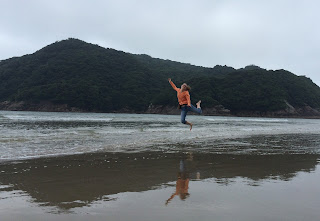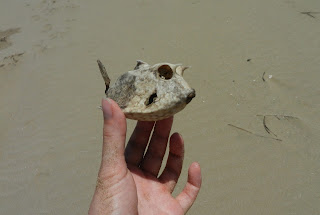7 July – 13 July
I was told it would be unlikely I would make it back to the
island for at least a week. I
didn’t believe it until it happened.
It is important (and frustrating) to note that the weather
itself has not been bad (yet). The
ocean waves are just too rough to make it across to the island. Even though (and possibly because) the
island is so close, the waves are especially rough between it and the mainland
– waves come from both directions and meet into a choppy bay of no travel.
 |
| That is the boat dock... |
 |
| My attempt to fly to Koshima. |
Cecile, a French student at the Primate Research Institute/Kyoto University and her
friend Clemence, a student at University of Montpellier, stayed here for 4
days. It was so great to have the
company, and to meet international primatologists! Cecile has previously done fieldwork on Koshima, so she is
familiar with the area and introduced me to some locals, which was
fantastic. Hooray for new friends!
They left back to Inuyama on Thursday, and when the weekend
came, I was alone again (there are 2 people here working on weekdays
though!). However, Ichiki, the
tiny hippie/surfer town the field station is located in, is not a bad place to
be stuck! I pretty much have
a private beach, the area is tropical and beautiful. Life is quite stress-free.
 |
| The Field Station. |
 |
| Jog on the beach - gotta stay in shape for Koshima! |
 |
| Is this from a squid? Does anyone know? |
On Saturday I went to
Cafe10, a café owned by the family Cecile introduced me to.
It
was awesome! They were also so kind to host me for dinner :)
But, while the weather has been nice with rough seas, this
will not be the case for long. Here are some weather maps:
8 July: Oh man, three typhoons in the area!! At least they are south of me.
11 July: But wait!
Typhooon #3 is moving north!
13 July: Holy crap!
It is coming right towards us! And there is a FORTH typhoon on the way!
Here is a map of the waves resulting from the southern
typhoon (typhoon #2). I'm on the east coast of that big chunk of land near the middle.
Here is a current wave map. Notice the legend…that is in METERS.
The typhoon should hit sometime around Thursday. Yesterday the post doc working at the
field station gave me an emergency briefing. Apparently there was an earthquake yesterday too, but I
didn't feel it. If there is a
tsunami, an alarm will sound and I am supposed to run up a nearby hill to a
high look-out. If there is a bad
typhoon or something of the sort, an announcement will be made in Japanese that
will tell people to prepare, buy food, etc. So, alarm = go to hill. Voice over the speaker = stay in.
Also, I have this:
Wish me luck! :P






















































